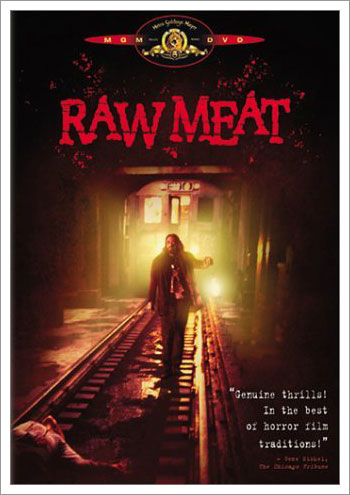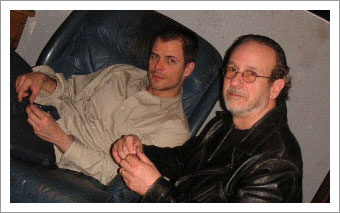Chicago native Gary Sherman began directing movies in the late '60s. His 1972 horror feature Death Line (aka Raw Meat) follows two modish twenty-somethings into the subway, where they find an injured man. After the man's body disappears, the couple help police track down a plague-ridden group of cannibals who have lived for decades in London's underground. Following the movie's successful release in England, it gained critical acclaim and a cult following, but it also pegged Sherman as a genre director. In fact, he had a difficult time getting Hollywood to let him create anything but horror for the next 20 years. So, why would he come to Chicago's Music Box Theatre to introduce Death Line, and why is he making yet another horror film?
Death Line isn't a masterpiece by any stretch of the imagination, but it was masterfully shot despite a very small budget. At the time, horror was just coming into its own as a film genre, and Death Line helped it define its parameters. It also has many of the qualities that make a good cult film: good music, an attractive lead actress, and lots and lots of over-the-top dialogue. It has the kitschy porn feel common to many films of its era. All dark alleys and neon lights, the opening scene shows a government official walking past a strip club, then soliciting a prostitute in the subway. This theme, of the British upper classes (sometimes quite literally) trying to "stick it" to the common people, is the undertone of the entire film, and is yet another part of why it gained popularity then, and why it is still shown.

Death Line, aka Raw Meat
Because Death Line is essentially a movie about death and tragedy on the London subway, I asked Sherman if his movie hadn't gained a new significance in light of this year's terrorist bombings in London. He answered, "London, of course, is no stranger to bomb attacks on the Underground. I'm talking about the IRA here. That was happening when the movie was made. Of course, none of those attacks were to such a large extent as the ones this past year. But I think the film does say something more about our fear of the subway in general. I think for all of us, people in the U.S. included, the subway specifically, and the underground in general, represents some very engrained fear we have of things that are hidden, things lurking in the shadows."
At the time, audiences were also shocked by the movie's blood and gore, although the slit throats and impaled train workers in this film are tame in comparison to some contemporary horror flicks. Despite of the gore, or maybe because of it, Death Line became a favorite across Europe. (Its U.S. release was underwhelming.) In 2000, it was chosen by a panel of British critics and the British Film Institute as one of the "Ten Most Important British Horror Films of 20th Century." It's enjoying new attention now in the U.S., including a DVD release and a screening this month at the Music Box. And while Chicago audiences will not be amazed by the film, those in the know about horror will find it an interesting historic specimen, both for its skillful use of lighting and low budget effects and its attention to and interpretation of "the ghoul," as well as for its undertone of political comment on class and power.
Sherman directed a second horror film, Dead & Buried, which was butchered by the studios. He moved on to do the action thrillers Vice Squad and Wanted Dead or Alive. He made a lot of money, and a lot of friends. In fact, Martin Scorsese called Vice Squad the best film of the 80s. Sherman even had a chance at directing the drama Uncommon Valor — it would have been a big change for him, a film different enough to get him out of the horror genre once and for all. But the violence in Vice Squad had been so controversial, and had such a mixed reception, the studio refused to even meet with him. Instead, he directed a string of horror flicks including Poltergeist III.
Tragedy engulfed Poltergeist III. During filming, Heather O'Rourke, the child actress playing Carol Anne Freeling, died of complications from Chron's Disease. Sherman and his producers considered canning the film, but filmed a piecey ending at the insistence of the company execs. Disaffected and feeling burnt out, Sherman started directing television. His series Missing Persons was lauded by the press, and helped actress Jorja Fox (now of CSI) launch her career. After Missing Persons, Sherman traveled for a while.
Three years ago he came back to Chicago. He thought he would go into a short retirement, get some needed peace and rest. He had no plans to ever direct again; he thought he would stick to writing, which he could do from anywhere, especially from the place he considered home. He was born and raised here, and just missed it. "Chicago is such a beautiful city. I think it's one of the most interesting cities architecturally, especially for film. You can shoot a scene on a city street. Shooting east you'll have one look, one feel. And then when you shoot in the other direction, the mood will completely change. You don't have that kind of diversity in many other cities."
But it wasn't long before he became interested in the possibility of another horror film. Someone sent him a script, and he was hooked. It seems ironic that he had come back to Chicago to get away from the movies — he had been trying for so long to do things other than horror. But he finally saw a scary story that caught his attention, one that could challenge his filmmaking abilities in a way they hadn't been. This new film is called 39: A Film By Carroll McKane.

Actor Martin Cummins (left), who plays serial killer
Carroll McKane, and director Gary Sherman
Sherman saw in the script the possibility to make a new kind of horror film, one where the central character was the director. As such, the film would be shot with only the kind of equipment available to an amateur filmmaker. As the story goes, Carroll McKane is a serial killer. He is obsessed with fame, and as Sherman says, "Carroll is obsessed, among his other less palatable obsessions, with new media. He records everything. So why not allow him to be the sole filmmaker. Not some other director, not me, not some studio or production company." Carroll kidnaps a psychiatrist, ties him up in his killing room, and forces him to be the witness and participant for his two final slayings, numbers 38 and 39. The story promised to be more disturbing than anything Sherman had done before. It also promises to be an innovative film, much like Death Line was in the '70s. For all intents and purposes, with no guise of cameramen or external characters, it will be one of the most intimate looks at a serial killer (albeit a fictional one) that has been shown on screen.
All early press indicates this film will be as gory, violent, and controversial as Sherman's work in the '70s and '80s. But this time the Chicago director has the advantage. Recent gore flicks such as Saw and the remake of Texas Chainsaw Massacre were box office hits and favored by many film reviewers. A release date is not yet set for the film. When it is released, Sherman again will have to face the opinions of his critics. And it's likely that this film will disgust more than a few of them. Now Sherman has been through enough that he is ready to take them on. It seems he has finally decided that, if the industry wants him to give them horror... he's going to give them horror.
Director Gary Sherman will be appearing at the screening of Death Line during the Music Box Massacre 24-hour horror film festival on Saturday, October 15, 2005.





